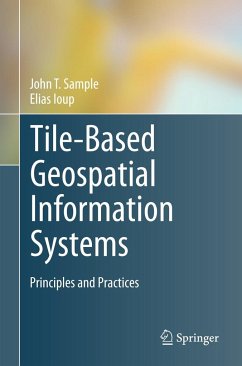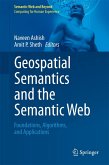Tile-based online mapping systems have replaced traditional Web GIS systems, because of their improved speed and usability. The trend towards tile-base systems was started by Internet services companies, such as Google, Yahoo, and Microsoft. They have been followed by the traditional GIS community, government organizations and open source development communities, because tile based systems yield faster and work stronger with 3-D mapping tools.
Tile-Based Geospatial Information Systems: Principles and Practices presents a detailed examination of the principles of tile-based systems. Topics include discussions of projections, coordinate systems, image processing, data basing and indexing requirements and web access. Attention is devoted to understanding and development of algorithms needed to make tile-based systems functional and efficient. In addition to the theoretical examination of the topic, this book includes detailed practical content helpful to those charged with implementation of tile-based systems. Case studies are provided in the last 2 chapters of this book.
Tile-Based Geospatial Information Systems: Principles and Practices is designed for a professional audience composed of researchers, practitioners and government workers, focusing on geographic information systems and internet technologies and image processing techniques related to GIS. This book is also suitable for advanced-level students in computer science and geography as a secondary text or reference book.
Tile-based mapping systems have grown to become the dominant form of mapping system with the rise of Web-based mapping tools. The origin of this book is a desire to collect all our discoveries, techniques, and best practices for creating a til- mapping system into one combined volume. The intent of this text is to provide a comprehensive guide to the theory behind creating a tiled-map system as well as a practical guide to create a concrete implementation. Stennis Space Center, MS John Sample May 2010 Elias Ioup vii Acknowledgements The authors would like to thank the Naval Research Laboratory's Base Program, program element number 0602435N, for sponsoring this research. Additionally, the following people provided technical assistance without which this book would not have been possible: Perry Beason, Frank McCreedy, Norm Schoenhardt, Brett Hode, Bruce Lin, Annie Holladay, Juliette Ioup, and Hillary Mesick. ix Contents 1 Introduction . . . . . . . . . . . . . . . . . . . . . . . . . . . . . . . . . . . . . . . . . . . . . . . . . . . 1 1. 1 Background of Web-Based Mapping Applications . . . . . . . . . . . . . . . 1 1. 2 Properties of tile-based mapping systems . . . . . . . . . . . . . . . . . . . . . . . 2 1. 3 Book Organization . . . . . . . . . . . . . . . . . . . . . . . . . . . . . . . . . . . . . . . . . 2 2 Logical Tile Schemes . . . . . . . . . . . . . . . . . . . . . . . . . . . . . . . . . . . . . . . . . . . 5 2. 1 Introduction . . . . . . . . . . . . . . . . . . . . . . . . . . . . . . . . . . . . . . . . . . . . . . . 5 2. 2 Global Logical Tile Scheme . . . . . . . . . . . . . . . . . . . . . . . . . . . . . . . . . . 7 2. 3 Blue Marble Example . . . . . . . . . . . . . . . . . . . . . . . . . . . . . . . . . . . . . . . 10 2. 4 Mercator-Based Schema . .. . . . . . . . . . . . . . . . . . . . . . . . . . . . . . . . . . . 11 2. 5 Variable Start Tile Schemes . . . . . . . . . . . . . . . . . . . . . . . . . . . . . . . . . . 12 2. 6 Standardized Schema . . . . . . . . . . . . . . . . . . . . . . . . . . . . . . . . . . . . . . . 15 References . . . . . . . . . . . . . . . . . . . . . . . . . . . . . . . . . . . . . . . . . . . . . . . . . . . . . 15 3 Tiled Mapping Clients . . . . . . . . . . . . . . . . . . . . . . . . . . . . . . . . . . . . . . . . . . 17 3. 1 Tile Calculation . . . . . . . . . . . . . . . . . . . . . . . . . . . . . . . . . . . . . . . . . . . . 17 3. 1. 1 Discrete Map Scales . . . . . . . . . . . . . . . . . . . . . . . . . . . . . . . . . . 18 3. 1. 2 Continuous Map Scales . . . . . . . . . . . . . . . . . . . . . . . . . . . . . . . 20 3. 2 Tile Retrieval . . . . . . . . . . . . . . . . . . . . . . . . . . . . . . . . . . . . . . . . . . . . . . 22 3. 2. 1 Local Tile Storage . . . . . . . . . . . . . . . . . . . . . . . . . . . . . . . . . . .
Tile-Based Geospatial Information Systems: Principles and Practices presents a detailed examination of the principles of tile-based systems. Topics include discussions of projections, coordinate systems, image processing, data basing and indexing requirements and web access. Attention is devoted to understanding and development of algorithms needed to make tile-based systems functional and efficient. In addition to the theoretical examination of the topic, this book includes detailed practical content helpful to those charged with implementation of tile-based systems. Case studies are provided in the last 2 chapters of this book.
Tile-Based Geospatial Information Systems: Principles and Practices is designed for a professional audience composed of researchers, practitioners and government workers, focusing on geographic information systems and internet technologies and image processing techniques related to GIS. This book is also suitable for advanced-level students in computer science and geography as a secondary text or reference book.
Tile-based mapping systems have grown to become the dominant form of mapping system with the rise of Web-based mapping tools. The origin of this book is a desire to collect all our discoveries, techniques, and best practices for creating a til- mapping system into one combined volume. The intent of this text is to provide a comprehensive guide to the theory behind creating a tiled-map system as well as a practical guide to create a concrete implementation. Stennis Space Center, MS John Sample May 2010 Elias Ioup vii Acknowledgements The authors would like to thank the Naval Research Laboratory's Base Program, program element number 0602435N, for sponsoring this research. Additionally, the following people provided technical assistance without which this book would not have been possible: Perry Beason, Frank McCreedy, Norm Schoenhardt, Brett Hode, Bruce Lin, Annie Holladay, Juliette Ioup, and Hillary Mesick. ix Contents 1 Introduction . . . . . . . . . . . . . . . . . . . . . . . . . . . . . . . . . . . . . . . . . . . . . . . . . . . 1 1. 1 Background of Web-Based Mapping Applications . . . . . . . . . . . . . . . 1 1. 2 Properties of tile-based mapping systems . . . . . . . . . . . . . . . . . . . . . . . 2 1. 3 Book Organization . . . . . . . . . . . . . . . . . . . . . . . . . . . . . . . . . . . . . . . . . 2 2 Logical Tile Schemes . . . . . . . . . . . . . . . . . . . . . . . . . . . . . . . . . . . . . . . . . . . 5 2. 1 Introduction . . . . . . . . . . . . . . . . . . . . . . . . . . . . . . . . . . . . . . . . . . . . . . . 5 2. 2 Global Logical Tile Scheme . . . . . . . . . . . . . . . . . . . . . . . . . . . . . . . . . . 7 2. 3 Blue Marble Example . . . . . . . . . . . . . . . . . . . . . . . . . . . . . . . . . . . . . . . 10 2. 4 Mercator-Based Schema . .. . . . . . . . . . . . . . . . . . . . . . . . . . . . . . . . . . . 11 2. 5 Variable Start Tile Schemes . . . . . . . . . . . . . . . . . . . . . . . . . . . . . . . . . . 12 2. 6 Standardized Schema . . . . . . . . . . . . . . . . . . . . . . . . . . . . . . . . . . . . . . . 15 References . . . . . . . . . . . . . . . . . . . . . . . . . . . . . . . . . . . . . . . . . . . . . . . . . . . . . 15 3 Tiled Mapping Clients . . . . . . . . . . . . . . . . . . . . . . . . . . . . . . . . . . . . . . . . . . 17 3. 1 Tile Calculation . . . . . . . . . . . . . . . . . . . . . . . . . . . . . . . . . . . . . . . . . . . . 17 3. 1. 1 Discrete Map Scales . . . . . . . . . . . . . . . . . . . . . . . . . . . . . . . . . . 18 3. 1. 2 Continuous Map Scales . . . . . . . . . . . . . . . . . . . . . . . . . . . . . . . 20 3. 2 Tile Retrieval . . . . . . . . . . . . . . . . . . . . . . . . . . . . . . . . . . . . . . . . . . . . . . 22 3. 2. 1 Local Tile Storage . . . . . . . . . . . . . . . . . . . . . . . . . . . . . . . . . . .
From the reviews:
"This book will be of interest primarily to practitioners: developers and designers of software systems that need map or imagery graphics. ... The material is clearly presented and easy to understand, and includes pointers to how different commercial and open-source systems or technologies available today ... . All in all, this book is a decent introduction to problems and solution techniques in the limited domain of tile-based services for geospatial information." (R. M. Malyankar, ACM Computing Reviews, September, 2011)
"This book will be of interest primarily to practitioners: developers and designers of software systems that need map or imagery graphics. ... The material is clearly presented and easy to understand, and includes pointers to how different commercial and open-source systems or technologies available today ... . All in all, this book is a decent introduction to problems and solution techniques in the limited domain of tile-based services for geospatial information." (R. M. Malyankar, ACM Computing Reviews, September, 2011)









